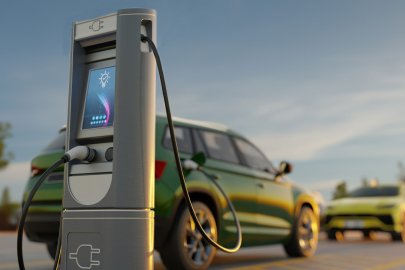Technologies from electric vehicles to electric water heaters, stovetops and even electric airplanes enable the electrification of our energy systems for a cleaner energy future. Each sector of the economy has promising technology at various stages of market readiness and adoption.
Electrification converts an energy-consuming device, system, or sector from non-electric sources of energy to electricity. Electrification requires consumers to purchase an electric technology to replace a product powered by fossil fuels. This includes purchasing an EV rather than a gas-powered vehicle or installing an electric heat pump instead of a furnace that uses natural gas in a home or building. These technologies “enable” electrification. Below are some of the electric technologies that are currently being used to electrify each sector.
Examples of Enabling Technology by Sector
| Transportation | Homes and Buildings | Industry | Agriculture |
|
|
|
|
The Advantages of Electric Technology
Emerging electric technologies are demonstrating benefits that go beyond decarbonization making them in many cases to be an economic choice. Some of the key advantages of electric technology include:
- More advanced features can lead to better work performance
- Higher overall energy efficiency and decreased maintenance costs lead to lower lifetime total costs over their non-electric counterparts
- Grid-connected electric technologies can run or charge during off-peak times, taking advantage of lower rates for consumers and reducing system demand during peak load times for utilities
- Supporting energy resiliency by utilizing stationary batteries for backup power solutions during outages, particularly when paired with solar
- Electric technologies do not generate emissions leading to better health outcomes.
Challenges With Implementing New Technology
New technology tends to be expensive. Higher upfront costs are a barrier to electrification in every sector and customer class. In addition, some technology may require costly upgrades to homes and other buildings. Unfamiliarity with the new technology and a lack of trained technicians to install and service the technology are additional barriers to electrification. The state of the technology and its market readiness may cause some consumers to balk when making decisions. For example, current battery technology limitations or the lack of a fast-charging network may make owning an EV impractical for some consumers. Commonly cited barriers to electrification technology adoption include:
- High upfront costs for both residents and businesses
- Costly building upgrades needed to support the technology may not be feasible
- Lack of familiarity with the technology and its benefits, including among trained technicians needed to install and service the technology
- Some consumers will choose to wait for the technology and markets to mature.
Overcoming Barriers to Adoption
Utilities—including gas utilities—are proactively and strategically offering programs and products to help their customers overcome some of the barriers to electrification. However, utilities are not alone in encouraging the adoption of electrification technologies. Vendors, municipalities, and states are also working to overcome barriers to help meet their clean energy goals. Some of these strategies include:
Customer Education
Familiarizing customers with electrification and its long-term benefits is key to widespread technology adoption. Many utilities have taken an energy consulting approach to help customers identify opportunities for electrification. Some utilities are even helping customers apply for available grants and funding to offset upfront costs.
Vendor Partnerships
Utilities are partnering with technology vendors and local contractors on technician training so can install and service electrification technologies. Often as a customer’s first point of contact, contractors can greatly influence technology adoption. Maintaining strong partnerships can ensure customers make the right decisions for their homes and businesses.
Financial Incentives
Grants and rebates from state and federal sources can help customers overcome cost barriers of electrification technology. Educating customers, who are often unaware of available financial incentives and lack time (or knowledge) to apply to them, is a responsibility shared by utilities, vendors, and government entities.
Updating Building Codes and Regulations
A few states have banned natural gas hookups in new construction, while other states and cities are taking smaller steps, such as requiring new homes to be wired for a level-2 EV charger and prewired for future electric appliances and solar panels. In some states, regulators are beginning to change or approve exceptions to rules that prohibit utilities from offering certain programs and products that could help their customers adopt electrification technology.
Filling Market Gaps
Some utilities and municipalities are targeting emerging electrification technology with programs and incentives to help create a market for the technology. Examples include putting electric bike charging stations on college campuses, and city- or utility-owned EV charging stations in areas that may not be profitable for private companies.





